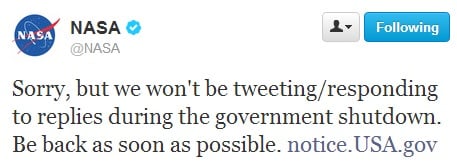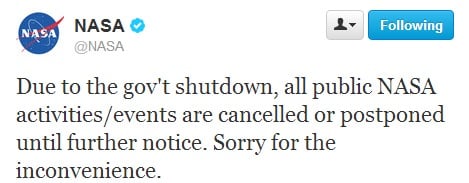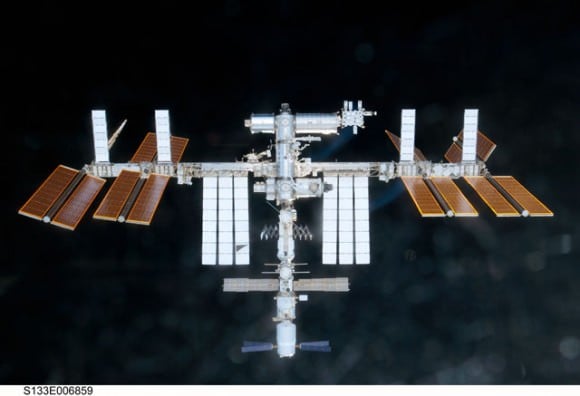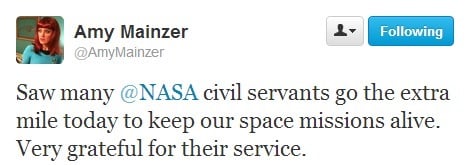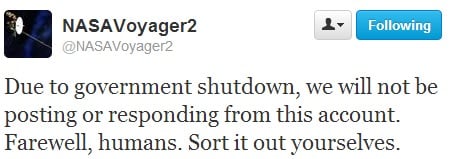A forthcoming NASA launch to Mars could be in danger of losing its launch window should a shutdown in the United States federal government that began today (Oct. 1) continue for a while. That's just one of the ways in which NASA is affected amid a lapse of funding that is affecting all government agencies and an untold number of government contractors.
Around 97% of NASA's 18,000 employees are off the job. Twitter, Facebook, Google Plus and other social media accounts are going dark. NASA's website is being pulled offline. NASA Television has also ceased broadcasting.
Beyond the agency's public face, activities ranging from
certain commercial crew payouts
, to conference attendance, to scientific work will cease. Awards and scholarship approvals will be delayed.
"NASA will shut down almost entirely," said President Barack Obama in a speech late Monday (Sept. 30).
In addition to the agency's public relations activities, NASA is
planning to launch the Mars Atmosphere and Volatile EvolutioN (MAVEN)
spacecraft to Mars in November to examine the Red Planet's atmosphere. There are all sorts of questions vexing scientists concerning that planet, with one of the most prominent ones being why the atmosphere thinned over the years.
Media reports indicate that if the shutdown is lengthy, MAVEN could miss the launch window and have to try again in 2016.
"A shutdown could delay the pre-launch processing currently under way with a possible impact to the scheduled Nov. 18 launch date," Dwayne Brown, a NASA senior public affairs officer at NASA,
told The Planetary Society
in a story published yesterday (Sept. 30). The launch window extends for several weeks beyond that time, however.
The 3% of NASA employees who are deemed essential will work without pay until the situation is resolved. These are some of the things that will continue:
[caption id="attachment_83861" align="alignnone" width="580"]
The International Space Station. Credit: NASA[/caption]
- International Space Station monitoring will be maintained, but with the bare minimum of ground crew. (NASA will cease regular updates of the astronauts' activities during the furlough, although we presume if something urgent happened there would be an update.)
- Robotic missions that are already in operation -- think the Cassini spacecraft circling Saturn, or the Lunar Atmosphere and Dust Environment Explorer (LADEE) winging its way to the moon -- will have small crews making sure that they are functioning properly. No scientific analysis will be conducted, though.
- Certain other programs will continue if a shutdown would be detrimental to their performance. Space News reports that the much-delayed James Webb Space Telescope will be among them, as some of its instruments are undergoing cryogenic vacuum testing at the Goddard Space Flight Center.
- Update, 1:09 p.m. EDT: Several missions run out of the Jet Propulsion Laboratory and Applied Physics Laboratory are running as usual for at least the next week because these facilities are running under contracted money from NASA and still have funds in the bank. According to the Planetary Society's Emily Lakdawalla: "At JPL, that includes: Curiosity; Opportunity; Odyssey; Mars Reconnaissance Orbiter; Cassini; Dawn; Juno; Spitzer; the Voyagers; and WISE, among many others. At APL, that includes MESSENGER and New Horizons. It also includes the Deep Space Network."
Additional Update, 2:09 p.m. EDT: The HiRISE twitter account just replied to inquiries from several space journalists that they will be "open for business" as usual, which is great news since the Mars Reconnaissance Orbiter made an audacious attempt to take images of Comet ISON during the comet's closest approach to Mars today. We'll provide any news and updates on images as they become available, but the HiRISE team said getting the images back to Earth and processing them may take a day or two.
HiRISE is still open for business and updates will continue as usual. — HiRISE (@HiRISE)
Many observers noted that NASA is marking its 55th anniversary today by shutting down its activities. There's no word yet on when the deadlock in Congress will be resolved. The
last two shutdowns in 1995 and 1996
(which began in the middle of the STS-74 shuttle mission to Mir) lasted several weeks.
 Universe Today
Universe Today

